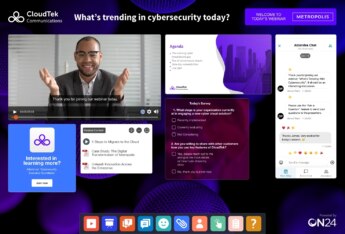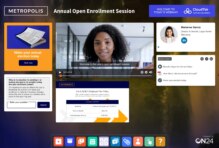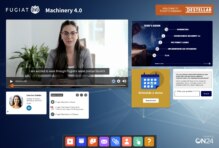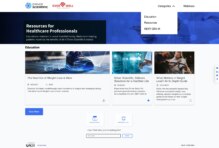The Complete Guide to Webinars
Webinars are an essential B2B marketing tool, allowing businesses to directly communicate with audiences, generate engagement and identify qualified leads. However, creating a successful webinar relies on more than just preparing a presentation, opening your webinar software and turning your microphone on.
A lot of behind-the-scenes work goes into preparing webinars that offer genuine value to attendees and help to fuel your business growth. Read on to learn more.

Webinar Definition
A webinar is a virtual seminar that is designed to provide information on a specific topic. The term webinar is a combination of the words “web” and “seminar.”
Webinars differ from other online presentations as they empower audiences to participate by asking questions, answering polls and using other interactive tools. This cultivates an immersive learning experience and encourages engagement.
Businesses, too, stand to benefit from the technology. Not only are webinars powerful lead-generation tools, but they can also help organizations accelerate pipeline by providing sales and marketing teams with more contextual information on a prospect or customer through insights generated by first-party data.
Platforms that facilitate webinars, such as ON24, pull together a combination of different technologies. Video conferencing, document sharing, live chats, survey tools and marketing automation tools are all used to form a cohesive, high-value experience for the viewer.
Webinar Formats
There are multiple webinar formats, each offering different ways for a brand to connect with its audience.
… allow you to deliver presentations and interact with your audience in real time. Being live provides the flexibility to tailor your delivery in the moment, optimizing around the audience to maximize impact.
Live webinars can also foster a sense of exclusivity, creating a buzz and improving attendance rates.
… are pre-recorded presentations delivered to live audiences. This can help to avoid presentation mishaps and gives you more time to interact with attendees.
You can answer questions via live chat while the recording is showing, conduct polls in response to what’s shown on screen, and take other steps to improve engagement.
… are pre-recorded and can be viewed in the audience’s own time. This makes them a convenient option and can help to widen the net of potential attendees.
On-demand webinars also facilitate rewatches, resulting in further audience engagement — especially when used in combination with content hubs.
… shake up the format by combining both live in-person events with virtual attendees. This format allows audiences to be in two places at once.
Hybrid webinars provide audiences greater flexibility, making it easier to work around scheduling conflicts, travel restrictions and other barriers.
… is a set of webinars all relating to one common theme. They can be used to progress through different subtopics or segment a deep dive into one complex idea. Serialized webinars can often mimic TV-like viewing experiences with familiar formats such as news, talk, and interview shows. They often have an established host and regular cadence.
As well as building on knowledge and offering in-depth topic exploration, series webinars forge brand trust and familiarity among viewers. They provide you with the opportunity to construct meaningful customer journeys and develop an organic relationship with your audience.
The Evolution of Webinars: From Seminars to Virtual Events
Webinars were created as an easy way to scale the reach of presentations by breaking down the barriers of time and geography. They were a lot more basic than the ones you know today. Most people were using dial-up internet, which was prone to disconnection, and the quality of video and audio was extremely limited. In fact, rarely would you see presenters on video.
Webinars today are multimedia experiences that engage attendees in a myriad of ways. Audiences are often on camera, can interact with presenters and network with each other, break into discussion groups and engage in Q&A sessions. Webinars can also be personalized with content options and promotions.
Why Choose Webinars?
Webinars can help showcase your expertise, connect with your audience and improve your bottom line. It’s no surprise they’re popular with professionals across a variety of sectors, from marketing teams and corporate trainers to healthcare providers and nonprofit organizations.
Here are some of the most common ways in which webinars can be used to help you achieve your goals.

Expanding Reach and Accessibility
We live in a digital world, but one of the few advantages still generally assigned to physical events is its ability to unite people in a single setting. Webinars turn that assumption on its head.
When you host a webinar, you can communicate with your audience in a live or on-demand environment without any of the limitations enforced by geographical constraints. You can connect with people from all over the world, regardless of location or other physical barriers.
The COVID-19 pandemic was a trial by fire of webinars’ unique capabilities – and the medium passed the test. According to the 2021 Webinar Benchmarks Report, Webinar attendance shot up by 251%, but the more impressive stat is that, despite the freedom to return to in-person events, only 11% of organizers say that this is what they plan to do.
It’s not all about expanding your reach geographically, though. Webinars also allow you to design a more inclusive environment for your audience.
With features such as closed captioning and sign language interpretation, you can make your webinar content accessible and open up the door to a wider audience.
Cost-Efficiency and Sustainability
Compared to physical events, webinars are by far the more cost-effective option. They eliminate the need to rent costly venues, hire catering and staffing, provide travel and accommodations and printed materials like banners, itineraries, and brochures.
Webinars are a great option if you’re looking for ways to scale the reach of your events without increasing costs.
Webinars are also more sustainable than physical events, as they reduce the waste generated and the carbon emissions associated with travel. For sectors where sustainability is a business priority, including companies that are committed to ESG principles, this can be a major benefit.
Deep engagement and interactivity
One of the most fundamental benefits of webinars is the number of opportunities they provide to engage audiences before, during and after your event. This is especially true when using an all-in-one audience engagement platform like ON24, where you have multiple tools at your fingertips to drive audience engagement.
Using features like polls, Q&A, and surveys to gather feedback and strengthen audience participation can greatly enhance the webinar experience. Breakout sessions take this to the next level, allowing you to divide participants into smaller groups for focused discussions and collaborative activities.
Running Q&A sessions helps to clarify content for viewers and encourage their continued interest. Many webinars also offer attendees the opportunity to request a one-to-one meeting for a more personalized touch.
You can even integrate lots of content options for audience members to download or calls-to-action, such as links to a free trial or demo, that they can engage with right from the webinar.
Tips to drive engagement
One of the most fundamental benefits of webinars is the number of opportunities they provide to engage audiences before, during and after your event. This is especially true when using an all-in-one audience engagement platform like ON24, where you have multiple tools at your fingertips to drive audience engagement.
Features like polls, Q&A and surveys to gather feedback and strengthen audience participation can greatly enhance the webinar experience. Breakout sessions take this to the next level, allowing you to divide participants into smaller groups for focused discussions and collaborative activities.
Running Q&A sessions helps to clarify content for viewers and encourage their continued interest. Many webinars also allow attendees to request a one-to-one meeting for a more personalized touch.
You can even integrate lots of content options for audience members to download or calls-to-action, such as links to a free trial or demo, that they can engage with right from the webinar.
Insights into Audience Behavior
Webinars provide a clear view of how your audience behaves, both as a collective and as individuals. This can help you to understand attendee interests and preferences, informing you to make better decisions in your future efforts.
Analyzing engagement metrics like poll responses, Q&A logs, content, downloads and chat activity can deliver deep insights and key areas of interest. Audience engagement can also help you identify those topics that most resonate for future events. By capturing, analyzing, and tracking your audience’s behavior all in one place, you’ll turn engagement into action and maximize your webinar’s value.
With first-party data collected through your webinars, you can use audience insights to optimize your marketing strategy, accelerate leads down the marketing funnel and empower your sales teams with the insights they need to continue the conversation and drive deals to a close.
Planning Webinars
Effective planning is the cornerstone of a successful webinar program. From setting clear goals to choosing the right solution, planning ensures you meet and surpass your objectives.

Setting Clear Goals and Expectations
The first thing you need to do when planning a webinar is establish clear goals. Without defining your objectives at the start, you’ll likely waste a lot of time getting distracted by everything you could be doing in your webinar rather than what you should be doing.
Clarify whether your primary goal is lead generation, product promotion, training or education early on. From there, you can identify the key performance indicators, or KPIs, that will be your benchmarks for success.
Webinar goals have evolved from simply measuring attendance to measuring audience engagement and insights and how effectively you were able to move people forward in their journey.
Your KPIs should be realistic and specific to your objectives. It might help to consider factors like your audience size and industry standards. If it’s your first time planning a webinar, remember that learning curves are natural – and utilize any support.
Identifying Your Target Audience
Almost as important as knowing your objectives is knowing your audience. To host a successful webinar, your content should be tailored to their needs and interests, and you can’t do that without first identifying who they are.
You might already have an audience group in mind, so this part should be easy. But, if not, conducting market research is always a good first step. You should establish your target demographics, such as age, location and industry, and have a full understanding of their needs, challenges and pain points so that you can create programming that will most appeal to them.
The more you know your audience, the more you can tailor your content and approach to meet their needs. This is often easiest done by segmenting your audience into smaller groups based on their interests and preferences or by developing buyer personas.
Choosing the Right Time and Webinar Platform
Webinar attendance can vary by a surprising amount depending on which day of the week it’s hosted on. In general, midweek si generally the best time for attendance rates.
It’s important to note that these stats can differ from industry to industry, such as B2B and B2C. That’s why the best thing to do is test different dates and times to see what works best for your own unique audience.
It’s important to choose a platform that can enable deep levels of interactivity and engagement to deliver an audience experience that will help you reach your goals.
ON24 Webinar Software
We’ve designed our ON24 webinar software with all of these considerations in mind – plus many more. Find out how our webinar solutions can streamline and enhance your buying journeys by registering for a live demo.
Creating Engaging Webinar Content
Choosing a high-value topic that addresses an audience’s need is critical to creating engaging webinar content. Ideally, you will identify that topic by having a keen understanding of your audience’s interests. Here are some tips on how you can take those interests and make your webinars shine:

Selecting the Right Speakers and Presenters
The content of your webinar is only as good as the person presenting it. Choosing the right speakers can make a big difference in how you present your content and engage your audiences.
Who you choose to lead your webinar depends on lots of factors, including what you’re trying to achieve and who your audience is. But the most basic criteria for effective webinar management are that your chosen presenters are knowledgeable and experienced. Choosing speakers who have a strong command of the topic being discussed increases the value of the presentation being given. A webinar can position your organization, and your presenters, as thought-leaders, but that relies on your content being relayed clearly and concisely.
Developing a Webinar Script
A webinar script is one of the most important factors for success. Get it right, and your audience will be engaged throughout. But get it wrong and you can lose their attention for good.
Think of webinar scripts as any other form of writing. First, it’s important to have a good understanding of the story that you are trying to tell. Once you understand the narrative, create an outline for how you will tell that story. This will guide you as you develop each section of your webinar script.
Focus on quickly capturing your audience’s attention with a hook, perhaps by providing context for why your story matters to the audience. From there, make sure your script flows naturally, avoiding sudden topic changes to ensure everyone can keep up with the content.
And don’t underestimate the power of a summary at the end of the session. This can help your audience consolidate all the knowledge they’ve gained, and it’s a great opportunity for you to reiterate the most important points.
In general, though, don’t overscript your webinars. Your host should be knowledgeable enough on the topic that they can speak off of the cuff to respond to audience questions.
Creating an outline and narrative flow of your content does not mean that you should script every word of your presentation. Audiences don’t want to be read to. If your presenters are knowledgeable about the topic, they should have no problem telling the story in their own words.
Brand Your Webinar
The next step is to build your webinar console, which the audience sees and interacts with during the event. A good webinar platform should allow you to completely customize every webinar experience to reflect your brand, corporate colors and any other creative elements needed to deliver a compelling audience experience.
Remember, your webinars are often the first impression your audiences get of your brand. A polished, professional-looking webinar console can go a long way to defining who you are as a company and building strong brand affinity over time.
Incorporating Interactive Webinar Elements
Webinars are at their best when they use multimedia and interactive elements. Being able to engage with audiences and track those engagement touchpoints and deliver valuable insights are key factors that differentiate webinars from in-person seminars, which don’t capture any audience participation.
Take a strategic approach to optimizing audience interactivity and engagement for every webinar. Dedicated webinar hosting platforms like ON24 give you the ability to build an experience with interactive elements, from basic tools like polls, live chat and Q&A to unique content offers and calls-to-action, such as links to web pages, free trials, demos, appointment setting options or other upcoming events.
Many webinars today, even include tools that facilitate full audience participation such as forums where audience members have their cameras on and join in an open discussion. Other webinars may deliver a presentation to a wider audience and move to smaller breakout sessions for more targeted conversations.
Using Visual Aids: PowerPoint Slides, Screen-Sharing and Video
Webinars allow you to augment your presentations with powerful visual aids, from PowerPoint slides, to screen sharing to integrated video clips. Using these tools in your presentation can boost your webinar’s engagement, helping you illustrate points and keep your audience’s attention.
Promoting Webinars
Promoting a webinar is arguably as important as creating the content itself. After all, webinar audiences don’t build themselves — it’s your job to generate interest and demand for your event. Here are some tips on how to make the most of your webinar promotions.

Leveraging Email and Social Media Channels
Email and social media marketing are two of the best channels for boosting webinar registration and attendance. Both offer an opportunity to talk directly to your audience and are perfectly suited for promoting your events quickly and effectively.
When you’re marketing your webinar, focus on creating a compelling message for why your audience will want to attend your event. There are a lot of ways to do this, from teasing the content you’ll be talking about to announcing exciting guest speakers or simply highlighting how your webinar will help your audience address a specific need.
Plan on a promotional cycle starting at least four weeks before your live date. This will allow you to promote your event multiple times without spamming your audience too often. Do not keep sending the same email to the same audience. Mix up your message, try different subject lines and email types. Experiment with sending your promotional emails at different times and on different days.
The same rules apply for social media: create a few unique posts that promote your event differently. Experiment with it when you post. The key is learning how your audience responds and when they typically respond.
Building Anticipation: Exclusive Offers, Guest Speakers
Another great way to drive registration for your event is to create exclusive offers, incentives and giveaways for event attendees. By giving your audience an additional reason to attend, you can effectively juice your event registration and overall interest.
If your upcoming webinar features guest speakers that have some name recognition with your audience, make sure to highlight them in your promotions. Encourage those speakers to share your webinar promotions through their own social channels to increase the reach of your event.
Hosting a Successful Webinar
You can go into a webinar with the best ideas and intentions, but if the execution isn’t successful, it’ll still fall short. These are our biggest tips for ensuring you host an effective webinar.

Technical Readiness
People might not remember that your webinar ran smoothly without any technical glitches, but they’ll definitely remember if it didn’t. Making sure you’re completely prepared to host your webinar from a technical perspective plays a key part in creating a positive impression on your audience.
The most important part of that preparation is choosing the right hosting software. A time-tested, robust, dedicated webinar hosting platform like ON24 is generally a better choice than using tools that are not dedicated to delivering high-quality events. This includes avoiding conferencing tools which are generally meant for hosting meetings and are not necessarily optimized for delivering robust webinar experiences.
On the hardware side of things, make sure to set aside time ahead of the webinar to test your cameras and microphones. This is a quick and simple process, but will save you from experiencing any embarrassing minutes spent trouble-shooting any technical issues at the start of your session – in front of your audience.
Engaging the Audience: Tips and Strategies
Most people think of a webinar as a one-way street: hosts talk, audiences listen, and never the two shall meet. But it doesn’t have to be that way. Webinar software makes it possible to engage with your audience seamlessly and meaningfully, bringing a new dimension to your webinar.
You can boost audience engagement with two simple strategies. The first is to assign someone the role of a webinar moderator — sometimes called a producer. Moderators, for example, can manage interactions between the audience and the speakers by collecting audience questions to fuel a Q&A period later in the event. A moderator can also manage conversations between guest speakers and audience members, all while keeping the session on track, and on time.
As discussed earlier, having interactive elements woven throughout the webinar, such as pushing out polls between content sections, or occasionally stopping to answer questions, can go a long way to keep your audience engaged and focused on the content being presented.
Offering Value: Exclusive Insights, Expert Advice
A webinar is a unique opportunity to broadcast your expertise and position your organization. You can do this through other mediums, like your website, but webinars are perfect for the job because you’ve got your audience’s full attention. In fact, according to our 2023 State of Digital Engagement Report, on average audiences spent 55 minutes engaging in a live webinar.
Leverage this opportunity by creating webinar content with a focus on delivering real value. Don’t waste too much time covering fundamentals that your audiences already know – prioritize the incisive, heavy-hitting, expert insights, tips and best practices that will not only provide value to them, but it will position your company as thought leaders and trusted advisors on the topics that matter most.
Also, try to avoid the “bait and switch” approach to your webinars. Don’t overtly promote your company and products, if you promised a best practices presentation on a specific topic. If your audiences want to learn more about your company, you can provide them with different calls to action so they can take that next step in their journey. However, pitch when it’s time to pitch. There is nothing wrong with creating webinars highlighting your company’s and products’ value.
Using Webinars to Maximizing Revenue
Quality webinar solutions are sometimes considered a luxurious addition to a marketing strategy, reserved for big brands with unlimited budgets. However, Investing in quality webinar software is important for companies of every size and type, as webinars are often one of the most powerful channels to enable employees, train partners, deliver certifications and so much more.
Webinars are particularly useful for driving pipeline and revenue. Here’s how.

Leveraging Webinar Engagement Data to Drive Pipeline and Sales
Webinars are perfect tools to accelerate the buyer’s journey. They’re great for generating demand, nurturing leads and even driving direct conversions. However, to turn a great webinar into a sales opportunity, you must integrate them properly with your existing marketing and sales infrastructure.
The benefit of engagement-driven webinars is all of the first-party data and insights that you get on your attendees. By integrating that data with your marketing systems, such as marketing automation software (MAP), you can more effectively qualify webinar leads and move them to the next logical marketing offer.
Using Webinar First-Party Data Effectively
This first-party engagement data becomes even more powerful in the hands of your sales teams. By integrating webinar data directly into your CRM systems, you can enable sales with valuable details about your prospects, such as what questions they asked, what content they downloaded or what calls-to-action they clicked on. With this data, reps are no longer making a cold call to follow up on a webinar lead, they are simply continuing a conversation.
The key to success is to ensure you’re using a platform that generates all of the data you need — and can integrate that data within your larger tech stack, like CRMs and MAPs. With the right data, you can learn what topics your audience was most engaged with, identify your best leads and more effectively convert them into pipeline and revenue.
This information can be invaluable as you develop new marketing and sales strategies. It might help you revise your buyer personas, inform your content strategy going forward, or even inspire a new campaign.
Effective Strategies for Post-Webinar Engagement
A lot of a webinar’s value actually comes when the live event ends. There are countless ways to extend the lifespan and reach of that experience and drive more valuable content.

Extending Engagement: On-Demand Viewing
Not everyone can attend a live webinar, so it’s important to make sure it’s available on-demand afterward.
You can host the entire on-demand webinar on your website or in a content hub to act as a valuable resource to power your prospect journeys. On-demand viewers will be able to enjoy the same interactive experience, content offers and CTAs as live attendees. According to our latest benchmarks report, 48% of webinar audiences will view them on-demand — not live.
Offering your webinars on-demand extends the lifespan of your webinar content and the reach of the experience, for beyond the live event.
Gathering Feedback and Analyzing Performance
Audience feedback after a webinar can be incredibly important. With webinar hosting platforms like ON24, you can integrate a webinar survey directly into the experience which will give the audience an opportunity to rate the speakers, the value of the content and suggest new topics for discussion.
You can even use audience surveys to create hand-raising opportunities, such as offering free consultations or giving them a chance to express interest in a product offering.
Try to collect a mix of qualitative and quantitative insights for the best outcome. And prioritize getting data that tells you what you can do to make future webinars even more valuable.
Repurposing Webinar Content
Webinars are a great source of reusable content. They typically cover a lot of ground, so you can divide your webinar up into smaller sections, and repurpose it in blog posts, social media threads, or even shorter-form videos.
In fact, with advances in generative AI, you can use your webinar content to automatically generate draft blog posts, e-books and articles.
You can even extend your content repurposing efforts to video as well. Using webinar analytics, you can quickly identify key moments in your webinar that can be used to create video clips that can power promotions for the on-demand version of the experience. Or these video clips can be integrated into future presentations.
Content repurposing is an effective way to maximize the total value your webinar delivers. In fact, you might even find that repurposing your webinar content ends up being as big a success as the webinar itself, multiplying the number of impressions you generate from the event.
Webinar FAQs
A webinar is an online-hosted seminar designed to share information about a specific topic. Webinars can be accessed from anywhere at any time from any device. These multimedia digital events are usually highly interactive experiences that enable audiences to participate in multiple ways including polls, surveys, Q&A and content options.
Webinars are usually around an hour long, the perfect amount of time to cover a topic in detail without your audience getting fatigued. They can, however, vary from as little as 10 minutes to a half day.
According to our annual State of Digital Engagement Report, audiences usually engage with a webinar for an average of 55 minutes. Click here to learn more.
Webinars can be either live or pre-recorded, and sometimes they’re a mixture of both. Pre-recorded webinars usually follow what’s called a “simulive” format, where content is recorded in advance but is scheduled to be broadcast as if it is live at a specific time.